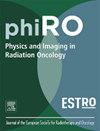Adaptive radiotherapy in locally advanced head and neck cancer: The importance of reduced margins
IF 3.4
Q2 ONCOLOGY
引用次数: 0
Abstract
Background and Purpose
Adaptive radiotherapy (ART) involves treatment re-planning based on anatomical changes, which may improve target coverage and sparing of organs-at-risk (OARs). This study retrospectively assessed the technical feasibility and potential benefits of daily ART in combination with reduced planning target volume (PTV) margins for head and neck squamous cell carcinoma (HNSCC).
Materials and Methods
Thirty-one patients, encompassing 902 treatment fractions, treated with radiotherapy to 60.0–68.0 Gy in 2 Gy/fraction were studied. Synthetic CTs (sCT) from daily kVCT images were created and contours propagated using deformable image registration (DIR). Target contours were reviewed and corrected. On the sCT, non-adapted delivered doses and ART-plans with 5 mm (clinical standard) and 2 mm PTV-margin were evaluated. All daily dose distributions were then accumulated.
Results
Target contours required correction in 48 % of the fractions. Daily non-adapted D98%,CTV was > 95 % in 890 (5 mm) and 825 (2 mm) out of 902 fractions. All adapted plans achieved D98%,CTV > 95 %. Significant reductions in mean doses to OARs were observed for PTV = 2 mm ART-plans: 4.1 Gy for parotid, 2.6 Gy for submandibular, 3.3 Gy for oral cavity, 4.0 Gy for esophagus, and 3.8 Gy for larynx.
Conclusion
ART-planning on sCT and DIR propagated contours was feasible and promising for further clinical testing. To obtain a potential clinical benefit of ART, a synchronous reduction of the PTV-margin was warranted. Daily ART can be used to maintain adequate target dosimetry for every fraction, though for the accumulated treatment, insufficient target coverage without ART is unlikely to occur.
局部晚期头颈癌的适应性放疗:缩小切缘的重要性。
背景和目的:适应性放疗(ART)涉及基于解剖变化的治疗重新规划,这可能提高靶覆盖和保留危险器官(OARs)。本研究回顾性评估了每日ART联合减少计划靶体积(PTV)边缘治疗头颈部鳞状细胞癌(HNSCC)的技术可行性和潜在益处。材料与方法:对31例接受60.0 ~ 68.0 Gy放射治疗的患者,共902个治疗组,放疗剂量为2 Gy/组。从日常kVCT图像中创建合成ct (sCT),并使用可变形图像配准(DIR)传播轮廓。对目标轮廓进行复查和校正。在sCT上,评估非适应给药剂量和5毫米(临床标准)和2毫米ptv边缘的art计划。然后累积所有日剂量分布。结果:48%的分数需要校正目标轮廓。在902个馏分中,890个馏分(5 mm)和825个馏分(2 mm)的日非适应率为98%,CTV为50% ~ 95%。所有改编方案均达到D98%,CTV >达到95%。PTV = 2mm art计划的OARs平均剂量显著降低:腮腺4.1 Gy,下颌骨2.6 Gy,口腔3.3 Gy,食道4.0 Gy,喉部3.8 Gy。结论:sCT和DIR传播轮廓的art计划是可行的,并且有希望进行进一步的临床试验。为了获得抗逆转录病毒治疗的潜在临床益处,需要同步缩小ptv切缘。每日抗逆转录病毒治疗可用于维持每个部分适当的靶剂量,但对于累积治疗而言,如果没有抗逆转录病毒治疗,不太可能出现靶覆盖不足的情况。
本文章由计算机程序翻译,如有差异,请以英文原文为准。
求助全文
约1分钟内获得全文
求助全文
来源期刊

Physics and Imaging in Radiation Oncology
Physics and Astronomy-Radiation
CiteScore
5.30
自引率
18.90%
发文量
93
审稿时长
6 weeks
 求助内容:
求助内容: 应助结果提醒方式:
应助结果提醒方式:


